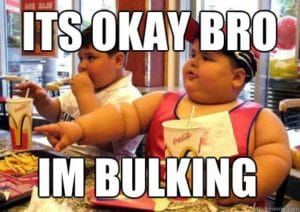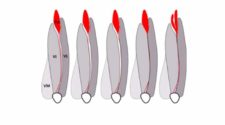Have you ever visited the gym, only to overhear a conversation between a few regulars that’s seemingly in a completely foreign language? Don’t worry, we’ve all been there. Each day, more and more gym slang is being created and it can be a little tricky trying to keep up with it all.
Thanks to this handy article, you can put your Google Translate app away for good. Below you’ll find a list of the 25 most popular gym terms explained, and finally be able to understand just what the heck everyone’s talking about.
1. Gains
This is possibly the most common piece of gym slang you’ll hear. ‘Gains’ simply refers to progress you’ve made in the gym. It’s predominantly used to describe gains in muscle mass.
However, you can have gains in area of fitness. You can make gains with your cardio by completing a larger distance or moving faster; you can make gains with your strength by lifting more weight or completing more reps. The only consistency is progress.

2. Swole
Getting ‘swole’ means being extremely muscular and big. For instance, you might remark on how swole someone’s arms look after finishing a set of bicep curls or if you haven’t seen them in a while and they’ve clearly been putting the work in.
3. Gym Rat
A gym rat is someone who spends a high amount of time in the gym. If someone’s constantly talking about their workouts, remarking on others’ fitness capabilities, or missing out on social events to train, then they’re a typical gym rat.
It’s also occasionally used to refer to anyone in the gym who thinks they know what they’re doing, but clearly does not.
4. Gym Bro
A gym bro isn’t just an everyday gym-goer. This is one that eats, sleeps, and breathes for the gym.
A gym bro is typically a young-ish jock-type gym-goer. He’s normally jacked, kitted out in the latest training gear, brash, cocky, and a bit of a show-off. He will also typically be found training with his other ‘bros’ and is very rarely alone.
Most gym bros spend hours upon hours working their chests, back, and biceps. From time to time, you may see them doing the occasional squat for good measure.
I’m not entirely sure where this particular example of gym slang originated from. It is likely that this slang became popular due to the ‘do you even lift, bro?’ memes that were making rounds on the web several years ago.
5. Roid Rage
When taking certain forms of anabolic steroids, individuals can develop a certain anger that has become associated with the drugs. Roid rage is a term used to refer to those who are clearly getting a little help outside of the gym and are in a little bit of a mood.

6. Weekend Warrior
You know how there’s people who hit the gym five days a week, week in, week out? Well, a weekend warrior is the opposite. Essentially, a weekend warrior are the people who only make it to the gym on a Saturday or Sunday when they can be bothered. These are your typical gym membership holders. They don’t use their subscription to its full extent and are quite content with the fact they’re simply paying the monthly fee as opposed to actually turning up consistently.
7. Cardio Bunny
A cardio bunny is anyone who spends all of their time on the cardio equipment (cross trainer, treadmill, bike, rowing machine, etc.) and likes to stay clear of the weight section. It’s usually used in association with women. Though, men can occasionally be called cardio bunnies, too, if they’re always pounding the treadmill instead of the bench press.
8. Juice Head
Juice heads are those incredibly large men who you can always hear grunting away in the weights section who tend to be rather intimidating. They’re very clearly on steroids or ‘juice’, though you’re far too nervous to ask.
You may also hear people mention ‘juicing’ i.e. “Yeah, that guy is definitely juicing”, and this once again means using steroids.

9. Jacked
In a similar fashion to ‘swole’, jacked means a particularly muscular individual. However, the terms differ in the sense that jacked often implies a certain leanness whilst those who are ‘swole’ can often err on the side of a slightly higher body fat percentage. For example, a bodybuilder may be ‘jacked’ whilst a powerlifter would be ‘swole’.
10. Shredded
Anyone who’s shredded has a very low body fat percentage with noticeable veins, popping abs, and all-round tight skin, though shredded individuals will also have a large amount of muscle. If you’re ‘shredded’, then you tend to be smaller than those who are ‘jacked’.
Also, you would not call just anyone who’s lean ‘shredded’. They would need to noticeably hit the gym.
11. Bro Split
A bro split is what most men first do when developing an interest in fitness: they train each body part on a different day.
Monday – Chest
Tuesday – Back
Wednesday – Shoulders
Thursday – Legs
Friday – Abs, Arms, and Calves
This is just an example of a typical ‘bro split’ but they can be fashioned in any manner.
The reason for their name is that they’re often constructed based upon advice from typical ‘bros’ in the gym: there’s no science to back up the structure apart from anecdotal evidence. Many bodybuilders swear by this split which is why it’s so popular. However, this is because many bodybuilders are also on steroids, and so almost any style of training works.
12. Spotter
When lifting heavy weights, you may require a spotter to make sure the weight doesn’t fall down on you, crushing your bones and leaving you severely injured. A spotter is someone who stands with you whilst you complete the lift and makes sure you don’t injure yourself by aiding in the lifting when the weight gets a little too much.
The most common lift a spotter is asked for is the bench press. The spotter will stand by the individual’s head, behind the bench and the rack, aid in lifting the bar from the rack, and then keep their hands underneath the bar for the entirety of the movement; not helping to lift the weight until the lifter gets fatigued and needs help lifting the bar back up.
Spotters can often be heard screaming “it’s all you bro!”, “you got this!”, “I’m barely touching the bar!”, and other words of encouragement.

13. Work-In
For the times where you need to work with the same weights or on the same weight as another person, you may ‘work in’ with their sets. This means you both take it in turns to use the equipment so that neither of you have to wait for the other person to finish.
14. One Rep Max
If you ever find yourself around strength-building athletes, one phrase you’ll hear repeatedly is ‘one rep max’. What exactly is it? Well, basically, your one rep max or 1RM, as it is sometimes abbreviated to, is the total amount of weight per exercise that you can lift for only one repetition. Say, for example, you are bench pressing and want to figure out how much your one rep max is. You would gradually perform 1 rep, increase the weight, and repeat until you reach your limit. If you can bench 250 lbs for one rep, your one rep max on the bench press is 250 lbs.
15. Macros
‘Macros’ is a shortened version of the term ‘macronutrients’. They are significant nutritional compounds that provide a number of bodily functions. There are three types of macronutrients: fats, proteins, and carbohydrates. You can count your macros intake in grams or by percentage. For example, an individual’s diet consists of 50 % of carbohydrates, 20 % of protein, and 30 % of fat per day.
16. Yogi
No, Yogi is not a bear. Well, he is, but if you hear people in the fitness biz talking about a yogi, they aren’t talking about the fictional cartoon bear. Instead, they are referring to a practitioner of yoga. That’s right: those that are proficient in yoga are actually known as yogis.
17. Sets and Reps
‘Yo, how many sets you got left, bro?’
If you’ve ever trained at the gym and heard that question, it’s important to understand what it means.
A set basically refers to the number of repetitions you choose to do for a particular exercise at a time. ‘Rep’ is a term used for repetition. One rep is each time you complete your chosen exercise.
For example, you follow a routine that requires you to perform 4 sets of 10 reps on the bench press. Each time you complete 10 reps, that will be one set.
18. Failure
When people talk about training to failure, they talk about training to the point that they cannot physically go any further. For example, you want to perform dumbbell shoulder presses to failure. You would grab your dumbbells, start shoulder-pressing them, and perform as many repetitions as you possibly could until you were physically unable to do another rep unassisted. Once your muscles are unable to press the dumbbells above your head and complete the exercise, you have failed.
19. Beast Mode
Beast mode is when everything’s going right: your mind is fully focused, you’re crushing all the weights, and nothing can stop you. Beast mode is the ultimate form of you. It’s the superhero deep inside all of us. It’s the inner animal waiting to be let out and go berserk in the weight room. You can enter beast mode on any piece of equipment, at any time. It essentially means giving your absolute all and going beyond what you’re normally used to.
20. Bro Science
A ‘bro split’ is a perfect example of bro science. Bro science is the advice you hear banded around the gym with no evidence or literature to back it up apart from, “I heard it from this really jacked guy once” or “X bodybuilder says he does it all the time from what I read on the internet”. Bro science is what we all unfortunately fall victim to at one time in our life. Whether it’s ridiculous arm workouts to gain 4 inches in a single day, or eating only chicken, broccoli, and rice to look like Arnie. It’s a phase we all go through and come out the other side better for it.
Whether it’s ridiculous arm workouts to gain 4 inches in a single day, or eating only chicken, broccoli, and rice to look like Arnie. It’s a phase we all go through and come out the other side better for it.
21. Bulking
Bulking refers to gaining mass; particularly muscle. When bulking, an individual will consume more calories than their body burns in order for these excess calories to be used to build muscle.
You may also hear of ‘dirty bulks’ which is where there’s no sense of health whatsoever and individuals will eat whatever they can get their hands on to gain muscle. This typically includes pizza, ice cream, doughnuts, chips, and burgers. Those who commit to ‘dirty bulks’ frequently gain more muscle and have to ‘cut’.

22. Cutting
Speaking of cutting, it’s simply the opposite of bulking: consuming less calories than your body burns so that it loses weight. Those who cut are trying to shred the fat from their body. Anyone can cut, but the most common reasons are for holiday, bodybuilding shows, or to get in shape for a partner.
23. Cheat Reps
Cheat reps are the repetitions you complete without strict form. For instance, have you ever seen someone smashing their hips into the bar in order to complete heavy bicep curls? Or not going to full depth on the squat? These can be cheat reps.
However, there is a difference between cheat reps and just being lazy. Cheat reps are a strategic method of overloading the muscles by using partial or aided ranges of motion. If someone only ever completes cheat reps, then they have a problem with their form and effort.
24. DOMS
Standing for Delayed Onset Muscle Soreness, DOMS is what you get after a particularly strenuous or different workout. If you can remember back to when you first started exercising, your body most likely ached for a large number of days afterwards. This is DOMS. It’s that ache that lets you know you’ve truly tested your body.
Contrary to popular belief, DOMS isn’t just a result of going hard in the gym; it can arise from simply using a muscle more than you’re used to. Despite frequently squatting, you may get DOMS in your legs from doing leg extensions because you’re placing more stimulus on your quadriceps than you otherwise would. This means anyone can get DOMS at any time in their exercise lifespan.

25. Miring
‘Miring is just the shortened version of ‘admiring’. An individual is said to be ‘miring when they’re checking out the gains of another individual. It’s not used in an attractive sense, it’s used more when someone looks or performs at a level you aspire to.
26. PB
Lastly, a PB is the second most used term after ‘gains’ and stands for ‘Personal Best’. If you can do something more than you could before, then you’ve hit a PB. It can be on the treadmill, doing a new yoga pose, holding a handstand, doing more reps on your deadlift, or simply doing a longer workout than you’re used to. It’s a way to mark your own progress and keep you up to date with where your fitness is at.
27. Free weights
While machines are fixed and designed to work specific section body parts, free weights, on the other hand are not fixed and can be transported around the gym, or anywhere else for that matter.
Usually, dumbbells, barbells, kettlebells, medicine balls, trap (hex) bars, and EZ bars are great examples of free weights.
28. Plates
The plates we’re talking about aren’t those that you eat your dinner from. The plates we’re focusing on today are those you find at the gym.
Weight plates are usually metal-made discs with or without a cover. They are used to load your barbell, EZ bar, other bars, and plate-loaded machines to lift weight in varying increments.
Typically, you will find weight plates in the following weights:
In metric units:
- 1.25 kg
- 2.5 kg
- 5 kg
- 10 kg
- 15 kg
- 20 kg
- 25 kg
In imperial units:
- 2.5 lbs
- 5 lbs
- 10 lbs
- 25 lbs
- 35 lbs
- 45 lbs
- 55 lbs
Some gyms also have bigger and heavier plates (e.g., 50 kg / 100 lbs) as well as smaller and lighter ones (0.5 kg / 1.25 lbs).
29. Cables
Cable machines (cables) in the gym operate from a pulley system and usually consist of: cable crossover machine, lat pull machine, and a dual adjustable pulley machine. Cables most often are used to exercise upper body muscles e.g. triceps.
Overall, the cables are nice because you can manipulate their accessories based on your need. In the case of a cable a crossover machine or dual adjustable pulley, the pulley itself can be adjusted in height. You can also attach a number of different handles and accessories to them.
Cable machines are typically weight stacked, though some models are plate-loaded.
30. Machines
When people hit the gym and refer to machines, they aren’t talking about the machines you’ll see in factories. They are also not associated with any from the future that travel back in time to get Sarah Conor. No, the machines they refer to are those found at the gym.
Machines in the gym are basically the opposite of free weights. They are great for isolating specific body parts. To work the chest with free weights, you’d do barbell or dumbbell bench presses. Whereas, if you use a machine to train your chest, you’d use things such as a: chest press machine or pec deck machine.
Machines can be plate-loaded or stack-loaded. In the latter, you simply select the weight you want to use with a pin, insert it into the stack, and do your set as normal.
Are you swole, jacked or yoked?







Leave a Reply